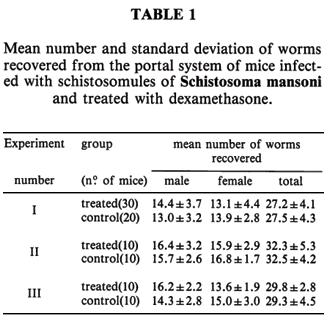BRIEF COMMUNICATION
Dexamethasone does not reduce the worm burden in mice infected with in vivo obtained schistosomules of Schistosoma mansoni
Marco V. Hermeto; Alan L. Melo; Rosilene S. Bicalho; Antonio P. Vargas; Fábio J. O. Favaretto; Leógenes H. Pereira
Grupo Interdepartamental de Estudos sobre Esquistossomose, Instituto de Ciências Biológicas da Universidade Federal de Minas Gerais. CEP 31.270-901 Belo Horizonte, MG, Brasil
The cercaria of Schistosoma mansoni must penetrate the skin of the vertebrate host to undergo many structural and physiological changes, originating a new organism, the schistosomule. This period is critical not only regarding to the changes themselves, as well as facing the host defenses7.
It is assumed that the effect of glucocorticoid therapy on the S. mansoni experimental infection, reducing the worm burden and retarding the parasite development, is patent when these drugs are given during the week of infection, when the parasite is passing through by this critical adaptation period1,2.
In a previous in vivo experimental study, a worm burden reduction was shown in mice infected with S. mansoni cercariae and treated with dexamethasone in the first week of infection. This reduction is an early process, presumably affecting the skin and/or the lung phases, hence the numbers of lung schistosomules were reduced from the second day of infection until the eighth day5. Possibly the glucocorticoid could interfere with the early processes of larval adaptation to the vertebrate host, as cercaria-schistosomule transformation. Thus, in the present report, aiming to confirm this hypothesis, schistosomules obtained in vivo from the peritoneal cavity were used to infect mice, thus eliminating the cercaria-schistosomule transformation phase.
Ten albino male mice (20 ± 2g) received an intraperitoneal inoculation with about 1,500 cercariae of S. mansoni (LE strain) shed by laboratory-reared Biomphalaria glabrata. These mice were sacrificed 4 hours after inoculation, and about 30% of the schistosomules were recovered as previously described6. These larvae were appropriately washed with saline and inoculated into 30 male naive mice (about 100 organisms/animal), by subcutaneous route. These animals were treated with dexamethasone (50 mg/Kg, subcutaneously) 1 hour before infection. Treatment with the same dose was also carried out from the second to the eighth day of infection. An untreated group of 20 mice infected with schistosomules served as control. Perfusion of the portal system for worm counts was performed six weeks after infection. The experiment was repeated twice with 10 mice/groups.
As can be seen in table 1 (results obtained from 3 different experiments), no statistical differences (Students't test) were verified in the worm burden of mice infected with peritoneal-obtained schistosomules and treated with dexamethasone, in relation to the untreated groups. The same was also observed in the S. mansoni sex distribution in treated and control mice.
Our results suggest that dexamethasone can act during the critical phase of S. mansoni larvae adaptation to the vertebrate host. This possibility is attractive, as some results obtained with the peritoneal cavity model indicate an evident slow-down effect of dexamethasone during the cercaria-schistosomule transformation3,4. Further studies are in progress, attempting to clear up this troublesome effect of the corticoids.
ACKNOWLEDGEMENTS
The authors are indebt to Dr. P. Williams for reviewing this manuscript.
Recebido para publicação em 22/09/1992
Aceito para publicação em 15/03/1993
Supported in part by CNPq and Fapemig (Brazil)
- 1. COKER, C.M. - Effects of cortisone on immunity to Schistosoma mansoni in mice. Proc. Soc. exp. Biol. (N. Y.), 96: 1-3, 1957.
- 2. HARRISON, R.A. & DOENHOFF, M.J. - Retarded development of Schistosoma mansoni in immunosuppressed mice. Parasitology, 86: 429-438, 1983.
- 3. HERMETO, M.V.; BICALHO, R.S.; MELO, A.L. de & PEREIRA, L.H. - Schistosoma mansoni: transformaçăo da cercária em esquistossômulo sobre imunossupressăo do hospedeiro. In: CONGRESSO DA SOCIEDADE BRASILEIRA DE MEDICINA TROPICAL, 25, Florianópolis, 1989. Resumos p. 175. res. nş 160.
- 4. HERMETO, M.V.; BICALHO, R.S.; MELO, A.L. & PEREIRA, L.H. - Efectos de la dexametasona a la adesion celular de las larvas del Schistosoma mansoni en la cavidad peritonial de ratones. In: CONGRESO LATINOAMERICANO DE PARASITOLOGIA, 9, Caracas, Venezuela, 1989. Resumenes. p. 190.
- 5. HERMETO, M.V.; BICALHO, R.S.; MELO, A.L. & PEREIRA, L.H. - Kinectics of the pulmonary phase of Schistosoma mansoni in mice treated with dexamethasone. Rev. Inst. Med. trop. S. Paulo, 32: 168-171, 1990.
- 6. MELO, A.L.; MACHADO, C.R.S. & PEREIRA, L.H. - Differences between in vitro and in vivo obtained schistosomules. Rev. Inst. Med. trop. S. Paulo, 32: 84-85, 1990.
- 7. STIREWALT, M.A. - Schistosoma mansoni: cercaria to schistosomule. Advanc. Parasit., 12: 115-182, 1974.
Publication Dates
-
Publication in this collection
21 July 2006 -
Date of issue
Aug 1993
History
-
Received
22 Sept 1992 -
Accepted
15 Mar 1993


